Figures & data
Table 1 Basic Data of Patients with Acute Intracerebral Hemorrhage
Table 2 Basic Data Between Study Group and Validation Group Among Patients with Acute Intracerebral Hemorrhage
Figure 1 Flow diagram for selecting appropriate patients with acute intracerebral hemorrhage. A cohort of 436 patients underwent an initial assessment in accordance with the enrollment criteria, and 276 patients were finally selected as eligible subjects for further clinical study after 160 patients were removed from this study. Subsequently, they were randomly divided into two group at a ratio of 2:1. The study group comprised 184 patients, 98 with 3-month cognitive impairment after stroke, and the validation group comprised 92 patients, 52 of whom experienced 3-month cognitive impairment post-stroke.
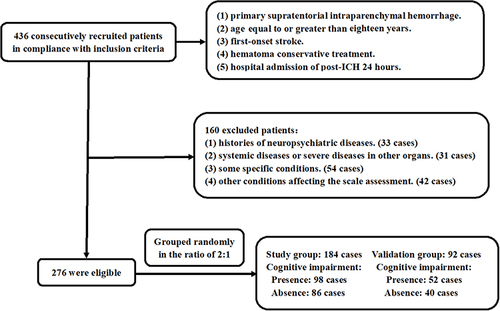
Table 3 Factors in Relation to the Montreal Cognitive Assessment Scale Scores at Three Months After Acute Intracerebral Hemorrhage
Figure 2 Serum translocator protein levels at admission and Montreal Cognitive Assessment Scale scores three months after acute intracerebral hemorrhage. Serum translocator protein levels at admission were significantly inversely related to three-month Montreal Cognitive Assessment Scale scores following acute intracerebral hemorrhage (P<0.001).
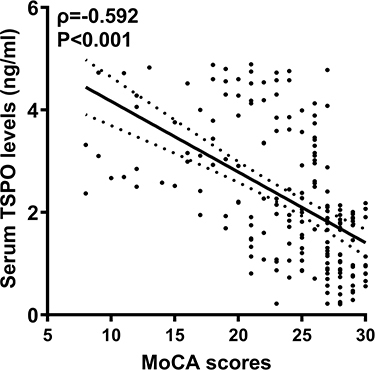
Table 4 Factors in Relation to Cognitive Impairment at 3 Months After Acute Intracerebral Hemorrhage
Figure 3 Serum translocator protein levels at admission and cognitive impairment three months after acute intracerebral hemorrhage. Cognitive impairment was defined as a Montreal Cognitive Assessment Scale score < 26 points. Serum translocator protein levels at admission were substantially higher in patients with 3-month cognitive impairment than in those without 3-month cognitive impairment (P<0.001). Serum translocator protein levels were shown as median (lower-upper quartiles).
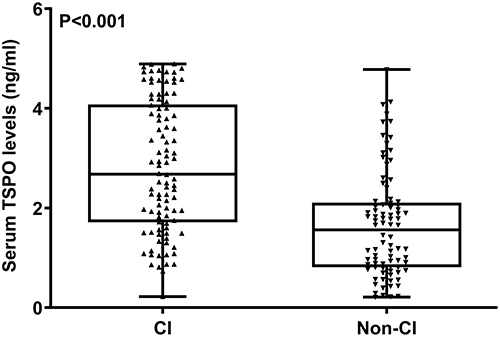
Figure 4 Restricted cubic spline showing the relationship between admission serum translocator protein levels and the likelihood of 3-month cognitive impairment after acute intracerebral hemorrhage. Serum translocator protein levels at admission were linearly correlated with the risk of cognitive impairment three months after acute intracerebral hemorrhage (P>0.05).
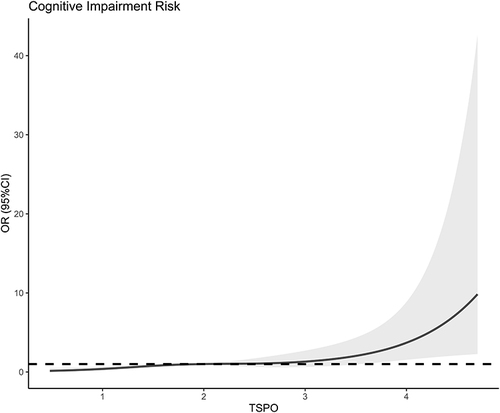
Figure 5 Subgroup analysis of the association between serum translocator protein levels and 3-month cognitive impairment after acute intracerebral hemorrhage and interaction analysis between subgroups. The relationship between serum translocator protein levels and cognitive impairment was not substantially influenced by other parameters, such as age, sex, drinking, smoking, hypertension, diabetes mellitus, body mass index, and dyslipidemia (all P for interaction > 0.05).
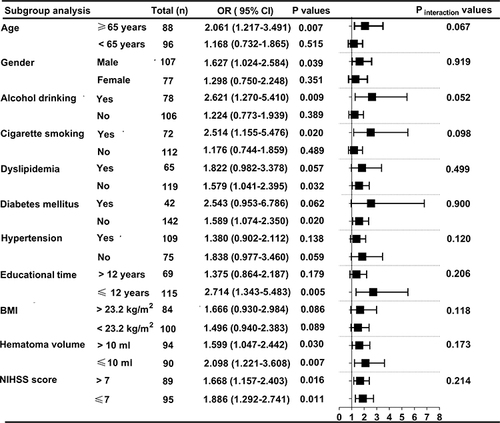
Table 5 Additive Effects of Serum Translocator Protein Levels Between Study Group and Validation Group with Respect to Predicting Cognitive Impairment at 3 Months After Acute Intracerebral Hemorrhage
Figure 6 Receiver operating characteristic curve of admission serum translocator protein levels predicting cognitive impairment 3 months following acute intracerebral hemorrhage. Using the Youden method, serum translocator protein levels > 2.18 ng/mL distinguished the risk of cognitive impairment 3 months after acute intracerebral hemorrhage with medium-high specificity and sensitivity. The black arrow indicates the cutoff value of serum translocator protein levels.
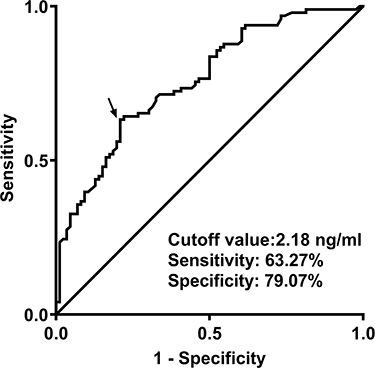
Figure 7 Nomogram describing the prediction model of cognitive impairment 3 months after acute intracerebral hemorrhage. A nomogram was constructed to visually display the prediction model of post-stroke three-month cognitive impairment in which serum translocator protein levels, National Institutes of Health Stroke Scale scores, and hematoma volume were integrated.
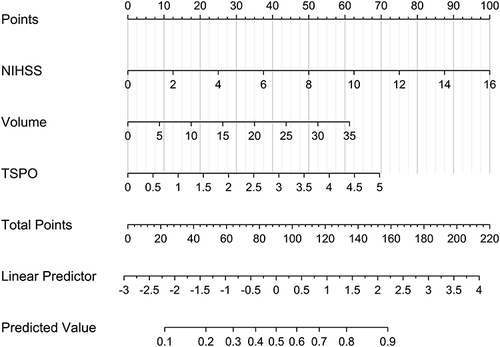
Figure 8 Calibration curve showing stability of the predictive model of cognitive impairment three months after acute intracerebral hemorrhage. The prediction model remained stable for the prediction of cognitive impairment three months after acute intracerebral the calibration curve.
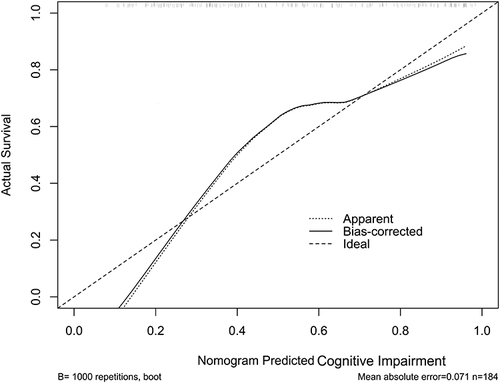
Figure 9 Receiver operating characteristic curve with respect to discriminatory ability of the prediction model for cognitive impairment three months after acute intracerebral hemorrhage. The prediction model, which contained serum translocator protein levels, National Institutes of Health Stroke Scale scores, and hematoma volume, had a significantly higher predictive ability for cognitive impairment 3 months after acute intracerebral hemorrhage, in contrast to the combination of National Institutes of Health Stroke Scale scores and hematoma volume (P<0.05).
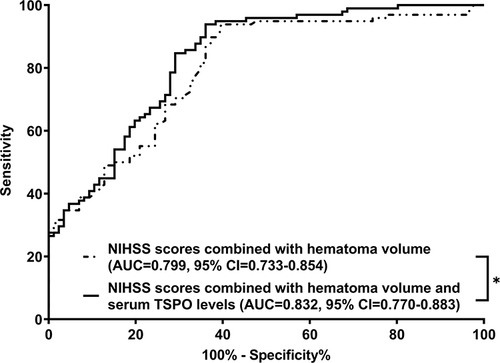
Figure 10 Decision curve exhibiting the clinical benefit of the prediction model of cognitive impairment 3 months after acute intracerebral hemorrhage. The prediction model, which contained serum translocator protein levels, National Institutes of Health Stroke Scale scores and hematoma volume, was clinically beneficial in predicting cognitive impairment three months after acute intracerebral hemorrhage.
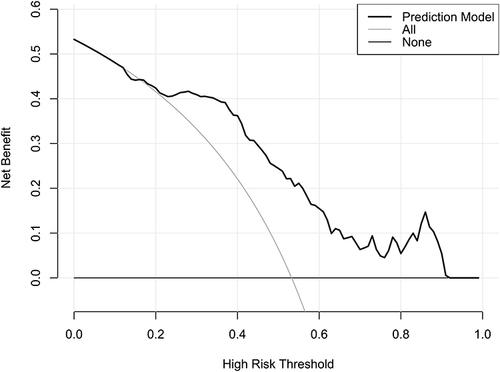
Data Sharing Statement
The datasets generated and/or analyzed during the current study are not publicly available because they are personal data, but are available from the corresponding author upon reasonable request.
